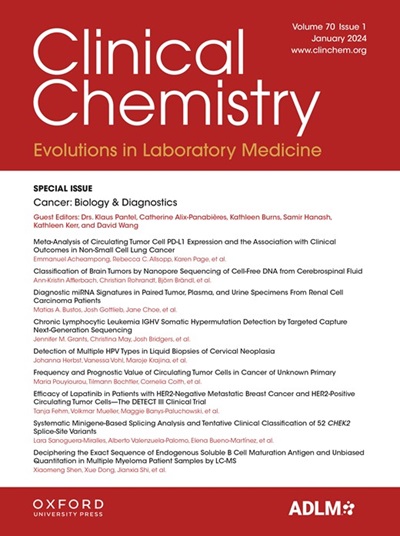A-192 Effectiveness in Communicating Critical Results: impact of technology and consultive actions on improving performance indicators in a laboratory in Northeast Brazil
IF 7.1
2区 医学
Q1 MEDICAL LABORATORY TECHNOLOGY
引用次数: 0
Abstract
Background Critical results consist of laboratory test results that require immediate intervention or decision-making by the responsible medical team, as they pose a risk to the patient's life. To manage the process of communicating critical results, it is also necessary to define the indicators, goals and systematic comparability through benchmarking. Methods The performance of the indicators measuring the critical results process for the year 2023 was analyzed. Performance indicators such as resolution time, success and failure rate in communication, delay rate in communication and the rate of open incidents related to the communication of critical results were monitored using a Business Intelligence tool. Results In the first two months of 2023 the results reflected the absence of parameters in the LIS for effective communication of critical results. September and October there was a high turnover rate in the laboratory in addition to the change in the hospital care profile in which the laboratory medicine service was inserted. These causes culminated in a number of 122 (1.48%) communication failures, representing an increase of 1,120% compared to the first two months of the year. On the other hand, there was a significant improvement in the average communication time for critical results, decreasing from approximately 736 hours to 184 hours(reduction of around 75%). There was also a reduction in communication delay of approximately 67%. These numbers corroborate the parameterization actions in the system aimed at speeding up the process. As a continuation of the improvement actions, the laboratory implemented goal setting for the resolution time indicator and also the periodic meeting for critical analysis of the results.In addition to these actions, the laboratory approached the hospital's clinical staff, making it possible to provide clarity on the difference between compulsory notification and critical results. This clarification allowed for the establishment of a list of exams considered critical, in order to meet the hospital profile, as well as to define the communication flow. For the success indicator in communicating critical results, there was a 22% improvement when comparing the last two months of 2023 with the first two months of the same year. In the last two months of the year, this indicator performed at 99.4%, corroborating the study published by Noronha et al., (2016), where the effectiveness rate in critical results communication was 96.1%. Comparing with the study by Noronha et al., (2016), where the biochemistry sector had the highest rate of critical results communication failures (73.8%), followed by the Emergency Room (78.6% ) and ICU (16.7%), the findings of this study highlighted the top 3 detracting sectors: Biochemistry (68%), “UPA” - Emergency Care Unit (42.1%) and ICU (21.4%), making data superimposable. Conclusions The communication of critical results has challenges related to its effectiveness, especially in hospital contexts. As a critical and high-impact activity, constant actions are necessary to continuously improve the process. Actions should take into account: interactions with attending physicians, the development and training of the internal team, and constant checks of the LIS, as technology can support the process management.A-192 有效通报关键成果:技术和协商行动对改善巴西东北部一家实验室绩效指标的影响
背景 危急结果是指需要负责的医疗团队立即干预或决策的实验室检测结果,因为它们对病人的生命构成威胁。要管理好危急结果的通报过程,还必须确定指标、目标,并通过基准进行系统比较。方法 对衡量 2023 年关键结果流程的指标绩效进行了分析。使用商业智能工具对解决时间、沟通成功率和失败率、沟通延迟率以及与关键成果沟通相关的未决事件率等绩效指标进行了监测。结果 在 2023 年的头两个月,结果反映出 LIS 中缺乏有效通报重要结果的参数。9 月和 10 月,实验室人员更替率很高,此外,医院的护理模式也发生了变化,实验室医学服务被纳入其中。这些原因导致了 122 次(1.48%)沟通失败,与今年前两个月相比增加了 1120%。另一方面,关键结果的平均通信时间有了明显改善,从大约 736 个小时减少到 184 个小时(减少了约 75%)。通信延迟也减少了约 67%。这些数字证实了系统中旨在加快进程的参数化行动。作为改进行动的延续,实验室还对解决时间指标进行了目标设定,并定期召开会议对结果进行批判性分析。除了这些行动外,实验室还与医院的临床工作人员进行了接触,从而明确了强制性通知与批判性结果之间的区别。通过这一澄清,制定了一份被认为是关键的检查项目清单,以符合医院的要求,并确定了沟通流程。2023 年的最后两个月与同年的前两个月相比,关键结果通报的成功率提高了 22%。在这一年的最后两个月,这一指标的执行率为 99.4%,这与 Noronha 等人(2016 年)发表的研究报告相吻合,在该研究报告中,关键成果沟通的有效率为 96.1%。在 Noronha 等人(2016 年)的研究中,生化部门的关键结果沟通失败率最高(73.8%),其次是急诊室(78.6%)和重症监护室(16.7%):本研究的结果突出显示了前 3 个有影响的部门:生化科(68%)、"UPA"--急诊科(42.1%)和重症监护室(21.4%),这使得数据可以叠加。结论 关键结果的交流在有效性方面面临挑战,尤其是在医院环境中。作为一项关键且影响较大的活动,有必要不断采取行动,持续改进这一过程。行动应考虑到:与主治医生的互动、内部团队的发展和培训,以及对 LIS 的持续检查,因为技术可以支持流程管理。
本文章由计算机程序翻译,如有差异,请以英文原文为准。
求助全文
约1分钟内获得全文
求助全文
来源期刊

Clinical chemistry
医学-医学实验技术
CiteScore
11.30
自引率
4.30%
发文量
212
审稿时长
1.7 months
期刊介绍:
Clinical Chemistry is a peer-reviewed scientific journal that is the premier publication for the science and practice of clinical laboratory medicine. It was established in 1955 and is associated with the Association for Diagnostics & Laboratory Medicine (ADLM).
The journal focuses on laboratory diagnosis and management of patients, and has expanded to include other clinical laboratory disciplines such as genomics, hematology, microbiology, and toxicology. It also publishes articles relevant to clinical specialties including cardiology, endocrinology, gastroenterology, genetics, immunology, infectious diseases, maternal-fetal medicine, neurology, nutrition, oncology, and pediatrics.
In addition to original research, editorials, and reviews, Clinical Chemistry features recurring sections such as clinical case studies, perspectives, podcasts, and Q&A articles. It has the highest impact factor among journals of clinical chemistry, laboratory medicine, pathology, analytical chemistry, transfusion medicine, and clinical microbiology.
The journal is indexed in databases such as MEDLINE and Web of Science.
 求助内容:
求助内容: 应助结果提醒方式:
应助结果提醒方式:


